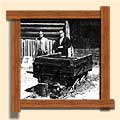 Heritage Community Foundation Presents
Heritage Community Foundation PresentsAlberta Online Encyclopedia
 |
|||
  |
|||
|
Home>> The Industry>> Historical Overview |
|||
| Historical Overview | |||
Collapse and Rebirth After the brief upturn during World War Two, the industry reached its darkest moment with the discovery of oil at Leduc in 1947. With cheap supplies of petroleum now available, the CPR announced in 1949 that it would convert its locomotives to diesel fuel. Within eight years, both transcontinental railways had made this change and the Alberta steam coal industry was almost completely shattered. While some collieries in the Crowsnest Pass and Cascade (Banff) fields survived, the mines at Nordegg and in the Coal Branch all closed. Meanwhile, electrical generation plants in Alberta were shifting from coal to natural gas, and domestic consumers were switching from coal to petroleum for home fuel. As a result of these factors, producers of domestic coal failed in large numbers. By 1960, coal production in the province of Alberta had fallen to less than one-quarter of what it had been a decade earlier.1
Increasing demand stimulated intense mining development in the Crowsnest Pass, in the Coal Branch area, further north at Grand Cache, and on the Alberta plains at Wabamun, Forestburg southeast of Edmonton, and at Sheerness east of Drumheller. In some cases, old mines were reopened, but much of the activity was in new areas, by newly-formed companies using surface-mining techniques. While strip mining had been practised in Alberta since the Great War, after 1945 the development of large draglines and other machinery made it practical in many cases for the first time. Giant companies such as Manalta Coal and Luscar were able to remove huge quantities of coal without the high labour costs attendant on tunneling and handwork. Because of the different characteristics of this industry, and its relatively recent history, it will not comprise a major focus of this report. Nonetheless, it was responsible for a tremendous expansion in production. By 1989, Alberta was the leading Canadian producer of coal with an output equivalent to about 27.9 million short tons, more than three times greater than the previous high point reached in 1950.3 William N.T. Wylie, "Coal-Mining Landscapes: Commemorating Coal Mining in Alberta and Southeastern British Columbia," a report prepared for the Historic Sites and Monuments Board of Canada, Parks Canada Agency, 2001. Listen: To hear a miner's perspective on the impact of oil and gas on the coal mining industry listen to John Carmata's oral history excerpt. See Also: The Coal
Industry—Overview, Rapid Expansion,
Domestic and Steam Coalfields,
1914-1947: The Struggling Industry, Collapse and Rebirth,
Settlement of the West,
Issues and Challenges—Overview,
Entrepreneurship, Technology,
Underground Techniques,
Surface Technology,
Surface Mining,
Social Impacts,
Unions,
1882-1913: Unionization and Early Gains,
1914-1920: Revolutionary Movement,
1921-1950s: Labour Unrest and
Setbacks, Mining Companies, People of
the Coal Mines,
The Middle Class,
Miners and Local
Government,
Politics and Economics ,
Environmental Impacts,
Health and Safety—Overview,
The State and
Labour Relations,
The State and
Development after 1918. |
|||
 |
|||
For more on coal mining in Western Canada, visit Peel’s Prairie Provinces.


